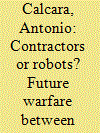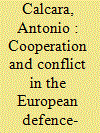|
|
|
Sort Order |
|
|
|
Items / Page
|
|
|
|
|
|
|
| Srl | Item |
| 1 |
ID:
188323


|
|
|
|
|
| Summary/Abstract |
Contemporary warfare is increasingly shaped by the complex relationship between the privatization of security and technologically driven automation. On the one hand, there is a growing tendency to employ private military and security companies for a range of military support tasks. On the other hand, the growing automation of security technologies is bound to make war less manpower intensive. Combat systems will have much more autonomy and humans will be working more closely with machines than they do today. The article provides an original analysis on the interplay between the privatization of security tasks and technologically driven automation and investigates their impact on the defence industry and the armed forces. These two sets of actors are arguably among the most impacted by the multi-faceted relations between privatization and automation. Technological progress creates the need for contractors to maintain and operate platforms that militaries do not have expertise to run. However, technologically driven automation - often developed in value chains far removed from the military-industrial pipeline - might also replace private contractors in non-core security tasks. The possibility to employ automated and autonomous systems will hence impact on the already delicate balance between private contractors and publicly-funded armed forces.
|
|
|
|
|
|
|
|
|
|
|
|
|
|
|
|
| 2 |
ID:
161526


|
|
|
|
|
| Summary/Abstract |
Defence-industrial collaborative activities have gained a central stage in the current European debate, based on the simultaneous presence of two systemic pressures (unipolarity and “defence-industrial globalization”) that are pushing EU member states towards more cooperation in these issues. Nevertheless, the European defence-industrial panorama still continues to be characterized by both cooperation and conflict. Protectionism, oligopolistic market straining and primary resource to domestic suppliers have prevented a more structured defence-industrial cooperation.
|
|
|
|
|
|
|
|
|
|
|
|
|
|
|
|
| 3 |
ID:
192031


|
|
|
|
|
| Summary/Abstract |
In “Will the Drone Always Get Through?,” we investigated empirically whether Medium-Altitude and High-Altitude Long-Endurance (MALE and HALE, respectively) drones make attacking comparatively easier or even easy in an absolute sense, as some analysts and scholars assume or claim. To conduct our analysis, we first translated existing arguments into testable hypotheses consistent with the literature on the offense–defense balance (ODB)—that is, whether drones shift the ODB toward the offense or to offensive dominance. Then we explored relevant disciplines such as radar engineering, electromagnetism, signal processing, and air defense operations to assess these competing hypotheses. For our analysis, we focused on current- and next-generation drones. Our findings suggest that current-generation drones neither lower the probability of interception by air defense systems compared to existing aerospace technologies, nor are they in the position to systematically avoid interception. Regarding next-generation drones, it is not possible to derive definitive conclusions, but our analysis suggests that scholars should pay more attention to how technological change affects the defense, not only the offense, as advances in semiconductors, big data, machine learning, and communications, among other fields, are going to significantly enhance air defense capabilities in the future.
|
|
|
|
|
|
|
|
|
|
|
|
|
|
|
|
| 4 |
ID:
174572


|
|
|
|
|
| Summary/Abstract |
Despite a growing “momentum” on European Union (EU) security and defence, there are no academic analyses that aim to systematically assess the role of the High Representative of the Union for Foreign Affairs and Security Policy and Vice President of the European Commission (HR/VP) in these strategic domains. This is surprising given that the HR/VP is one of the central actors in the complex institutional architecture of EU security and defence. To fill this gap in the scholarly literature and to contribute to a more fine-grained analysis of the two post-Lisbon Treaty HR/VPs, the article assesses Ashton and Mogherini’s mandates in these fields. This study is particularly relevant because the HR/VP’s hybrid institutional role may represent a unique analytical angle to investigate a formally intergovernmental sector, strongly shaped also by EU institutions’ authority over defence-industrial policy. Following these considerations, the article looks at how the two HR/VPs managed to navigate both the military and the defence-industrial dimensions of EU security and defence.
|
|
|
|
|
|
|
|
|
|
|
|
|
|
|
|
| 5 |
ID:
170469


|
|
|
|
|
| Summary/Abstract |
The European defense-industrial panorama is rapidly changing. Among all the initiatives conducted, the European Defense Fund (EDF) and the Permanent Structured Cooperation (PeSCo) in defense can be easily considered as proof of a revived interest in defense-industrial cooperation. Given this European activism, it is not surprising that the academic literature has focused on the main actors and the main strategic and economic drivers that have spurred European defense-industrial cooperation. However, the scholarly literature on the topic has erroneously over-emphasized the cooperative elements, while underestimating the peculiarities of a policy-field which remains characterized by both cooperative and competitive dynamics. Indeed, notwithstanding the presence of stable alliances, common regulations in defense procurement and a number of transnational business groups, the European defense-industrial field remains also fragmented in terms of both supply and demand. The article has two goals: first, it proposes a Liberal-Intergovernmentalist research agenda to explain the complex mix of cooperation and competition in this policy-field. Second, it aims to reflect on methodological issues in studying European armaments policies. Overall, the article wants to stimulate a constructive discussion, both from a theoretical and a methodological point of view, on a peculiar policy area that acts as an interface of industrial, technological and defense policies and lies at the intersection of International Relations (IR) traditional distinction between low and high politics.
|
|
|
|
|
|
|
|
|
|
|
|
|
|
|
|
| 6 |
ID:
184248


|
|
|
|
|
| Summary/Abstract |
There is an intense debate in international relations scholarship on whether the benefits accrued by arms production globalization outweigh the risks of depending on foreign suppliers. Europe is an interesting case: although regional protection could help Europeans mitigate exposure to global actors, the prospect of regional integration generates concerns about autonomy within Europe itself. We depict European defense cooperation as a “two-level playing field,” whereby market size informs a country’s hedging between global-external and European-internal competitors. First tiers push for defense market integration because they expect to be strengthened vis-à-vis global players but also because market size gives them a competitive advantage over fellow Europeans. Second tiers resist market integration, as they worry it might lead to first-tier dominance. To probe our hypotheses, we examine the behavior of two first tiers (France and Germany) and two second tiers (Poland and Sweden) in the context of the European Defense Fund.
|
|
|
|
|
|
|
|
|
|
|
|
|
|
|
|
| 7 |
ID:
190873


|
|
|
| 8 |
ID:
155694


|
|
|
|
|
| Summary/Abstract |
While many have noted that EU member states have different preferences over the prospect of an integrated EU defence, analyses that specifically explore state–industry relations in the definition of EU defence-industrial issues, and in the evolution of the Common Security and Defence Policy in general, are lacking. This is surprising, given that different configurations of government–industry relations have represented a persistent impediment to European defence-industrial cross-border collaboration. This article investigates how state–defence industry relations impact on member states’ preferences towards the EU defence-industrial framework. Based on the case studies of the interaction of France and the UK with the European Defence Agency, this analysis focuses on the difference between public and private defence firms’ governance settings as the crucial explanatory variable accounting for diverging member states’ preferences in this domain.
|
|
|
|
|
|
|
|
|
|
|
|
|
|
|
|
| 9 |
ID:
186185


|
|
|
|
|
| Summary/Abstract |
According to the accepted wisdom in security studies, unmanned aerial vehicles, also known as drones, have revolutionizing effects on war and world politics. Drones allegedly tilt the military balance in favor of the offense, reduce existing asymmetries in military power between major and minor actors, and eliminate close combat from modern battlefields. A new theory about the hider-finder competition between air penetration and air defense shows that drones are vulnerable to air defenses and electronic warfare systems, and that they require support from other force structure assets to be effective. This competition imposes high costs on those who fail to master the set of tactics, techniques, procedures, technologies, and capabilities necessary to limit exposure to enemy fire and to detect enemy targets. Three conflicts that featured extensive employment of drones—the Western Libya military campaign of the second Libyan civil war (2019–2020), the Syrian civil war (2011–2021), and the Armenia-Azerbaijan conflict over Nagorno-Karabakh (2020)—probe the mechanisms of the theory. Drones do not by themselves produce the revolutionary effects that many have attributed to them.
|
|
|
|
|
|
|
|
|
|
|
|
|
|
|
|
| 10 |
ID:
188892


|
|
|
|
|
| Summary/Abstract |
Do emerging and disruptive technologies yield an offensive advantage? This is a question of central theoretical and substantive relevance. For the most part, however, the literature on this topic has not investigated empirically whether such technologies make attacking easier than defending, but it has largely assumed that they do. At the same time, work on the offense–defense balance has primarily focused on land conflicts, thus offering little understanding of the effect of technological change in other domains, such as the air and sea. In this article we address these gaps by investigating whether current- and next-generation drones shift the offense–defense balance toward the offense or toward offense dominance, as many assume—that is, whether drone technology can or will defeat current- and next-generation air defense systems. To answer these questions, we have explored the literature in radar engineering, electromagnetism, signal processing, and air defense operation. Our analysis challenges the existing consensus about the present and raises questions about the future. Our findings also demonstrate how important it is for the field of security studies to embrace greater interdisciplinarity in order to explore pressing policy and theoretical questions.
|
|
|
|
|
|
|
|
|
|
|
|
|
|
|
|
|
|
|
|
|